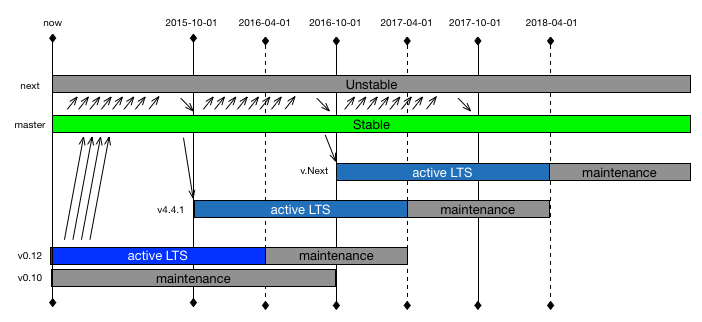See issues for discussion on kicking off this working group.
The Current LTS Plan is:
- The next LTS release will be cut from the Converged Repo (nodejs/node) once the convergence of the joyent/node and nodejs/io.js streams has been completed. The current target is to move to the fully converged stream by the end of August, 2015, with the first LTS release cut during the first week of October, 2015.
- After that, new LTS releases will occur once every 12 months, at the same time each year.
- Every LTS release will be actively maintained for a period of 18 months from the date the LTS release is cut. After the 18 months have passed, the release will transition into Maintenance mode until the current LTS release moves into Maintenance 12 months later. (That is 18 months of active LTS + 12 months Maintenance only).
- There will be no more than two active LTS releases at any given time, overlapping for a maximum period of six months.
- The existing joyent/node v0.10 will continue in Maintenance mode for approximately one year after the initial LTS release from the converged repo. The existing joyent/node v0.12 will continue in LTS for a period of 6 months after the initial LTS release from the converged repo, after which it will transition into Maintenance for 12 months.
- There will be no LTS releases cut from the nodejs/io.js stream.
- Once a release enters LTS, no new features may be added to that release. Changes are limited to bug fixes, security updates, possible npm updates, documentation updates, and certain performance improvements that can be demonstrated to not break existing applications, etc. Semver-minor changes are only permitted if required for bug fixes. Semver-major changes are only permitted if required for critical security and bug fixes.
- Once a release moves into Maintenance mode, only critical bugs, critical security fixes, and documentation updates will be permitted.
- semver-major bumps are permitted between LTS releases. The LTS release will be cut from the last stable release before a semver-major bump. The implication of this is that the semver-major bump should be timed to roughly coincide with the regular yearly LTS release schedule.
- Note that while it is possible that critical security and bug fixes may lead to semver-major changes landing within an LTS stream, such situations will be rare and will land as semver-minor bumps.
- All LTS releases will be assigned a "codename" drawn from the names of elements on the Periodic Table of Elements. For each upcoming LTS release, the LTS Working Group will select a handful of candidate names and submit those for a collaborator vote.
It should be stated that the abstraction layer (currently NAN) should
support all current LTS releases. Given that Active LTS will overlap
for a period of 6 months, this means that the abstraction layer will, at
any given point in time, fully support a maximum of 2 LTS releases.
The specific details may vary depending on the next and master release plan
that is ultimately adopted. However, the release plan will not impact the
schedule or proceses for managing an LTS release once it has been cut.
For example. Let's suppose that convergence of the source streams is completed. For the sake of the example, let's assume that the first converged stream release is v4.0.0 (the next major after the then current io.js release).
Let's suppose that the revised release plan currently being discussed in
nodejs/node#1997 is adopted. This would mean
that there are regular, periodic merges from the next branch into master
that trigger a semver-major bump (assuming at least two per year, six months
apart). Let's assume that the current master immediately before the next
merge is at v4.4.1. When the semver-major bump from next occurs, v4.4.1
becomes the LTS release. If there are several merges from next into master
through the year, the LTS release will still only occur once per year, at the
same time each year.
Let's assume (hypothetically) that this first LTS Release occurs on October 1st, 2015.
- nodejs/node v4.4.1 becomes the current LTS Release
- joyent/node v0.10 continues in Maintainance only mode until October 1st, 2016
- joyent/node v0.12 continues as LTS until April 1st, 2016, after which it moves into Maintenance only mode until April 1st, 2017.
- On or around October 1st, 2016, the second LTS Release from the converged is cut.
- LTS for v4.4.1 continues until April 1st, 2017, after which it moves to Maintenance mode until around April 1st, 2017.
- On or around October 1st, 2017, the third LTS Release from the converged is cut.
Note that one implication of this schedule is that assuming that next merges
into master twice per year, the LTS would be cut with a V8 version that is at
least six months old and that will need to be supported for up to 30 months
beyond the LTS release.
| Release | LTS Start | Maintenance Start | LTS End |
|---|---|---|---|
| v0.10 | (current) | 2015-10-01 | 2016-10-01 |
| v0.12 | (current) | 2016-04-01 | 2017-04-01 |
| v4.4.1 | 2015-10-01 | 2017-04-01 | 2018-04-01 |
| v.Next | 2016-10-01 | 2018-04-01 | 2019-04-01 |
